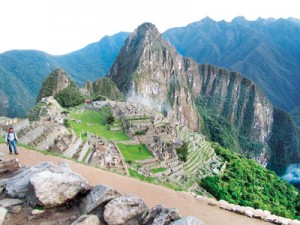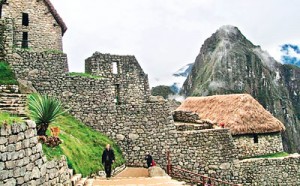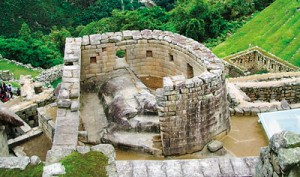Machu Picchu –Icon of the Inca Empire
View(s):By Sanjiva Wijesinha

View of Machu Picchu-with mountain Humayun Picchu in background
It is the icon of South America’s ancient Inca Empire – and the best known tourist attraction in Peru.
Located high in Peru’s Andes mountains, more than 2400 metres above sea level, the ancient Inca city of Machu Picchu has been granted recognition by UNESCO as a World Heritage site not only for its historical significance but also for its great natural beauty.
It is one of the few major Inca sites of South America to have escaped four centuries of looting and destruction by the Spanish conquistadors. Unlike many archaeological ruins, there are so many of the original buildings still standing today that the visitor doesn’t require much imagination to imagine what the city must have looked like in its heyday half a millenium ago.
Historians and archaeologists are still undecided as to what exactly the ruins of Machu Picchu represent.
Was this a religious citadel in which priests conducted religious ceremonies in an environment close to the mountain gods – the deities who played such an important role in Inca life? Was this an observatory to study the movements of the sun, the moon and the stars? Was this an ancient settlement – a sort of highland retreat (like Nuwara Eliya was during the days of our British colonial rulers) – for the Inca emperors?

Weathered stone: Buildings of Machu Picchu
Getting to the archaeological park of Machu Picchu was easy. Like most tourists we first flew into the international airport in Lima, the capital of Peru, and then took a domestic flight to the ancient Inca capital city of Cuzco. This city is 3400 metres above sea level, so it is essential for visitors accustomed to living at sea level in tropical Sri Lanka to adequately prepare themselves health-wise to avoid altitude sickness.
We travelled by train from Cuzco (which is a fabulous tourist attraction in its own right, with plenty of Inca ruins and some amazing colonial architecture) to the station that lies closest to Machu Picchu. This township is popularly known as Aguas Calientes (‘The Hot Waters’ – after its famous thermal springs) and is situated at the foot of the mountain. From here a 45 minute bus ride took us uphill along the winding mountain road to the entrance of the archaeological park.
The train journey we undertook from Cuzco to Aguas Calientes certainly enhanced our experience. The national rail network (http://www.perurail.com/) provides a special rail service that takes the traveller through some beautiful mountain scenery.
 Younger and fitter visitors can hike up along the old Inca Trail through the mountains to Machu Picchu – a four day journey starting in the sacred valley near Ollantaytambo. The journey is strenuous but affords some spectacularly unforgettable views along the climb up to the summit .
Younger and fitter visitors can hike up along the old Inca Trail through the mountains to Machu Picchu – a four day journey starting in the sacred valley near Ollantaytambo. The journey is strenuous but affords some spectacularly unforgettable views along the climb up to the summit .
The number of visitors to Machu Picchu archaeological park is strictly limited, so tickets are not available at the entrance. They have to be purchased through a licensed tour operator from the Ministry of Culture office in Cuzco. They can also be bought on the internet (http://www.machupicchu.gob.pe/). We conveniently arranged our entrance tickets as well as our flights, train travel and accommodation through a travel agent in Sri Lanka.
Allow at least a full day at Machu Picchu to fully appreciate the place – it is too much to take in on a half day tour. We made it a point to arrive in the afternoon, visit the site with a guide, stay overnight at the Belmond Sanctuary Lodge hotel situated at the entrance to the park (http://www.belmond.com/sanctuary-lodge-machu-picchu/) – and then spent a second day there with the idea of getting in to watch the sunrise from the summit and then savour the site at leisure during the rest of the day.
The man-made constructions of Machu Picchu have been cleverly and tastefully built not on the mountain but into the mountain – the built environment blending naturally with the stunning natural environment. One can appreciate how the architecture of these five hundred year old buildings is so aesthetically integrated with their surroundings.
The citadel surrounded by the massive green jungle-covered peaks is certainly awe-inspiring. Seated up here at sunrise, it was easy for us to imagine the Incas creating this place with the idea of being close and connected to their gods as they gazed up at the massive mist -covered mountains and the celestial bodies in the night sky above them.


